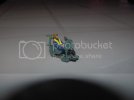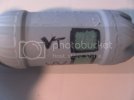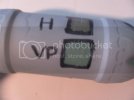Immortal
New Member
- Joined
- Nov 17, 2011
- Messages
- 7
I've recently re-started the hobby and I am working on one of my first models back, an Airfix 1:72 Spitfire. I'm learning how to Airbrush with a used Aztec I bought from a friend.
I primed the model with Vallejo's Grey Primer. I then sprayed Vallejo paint (I can't remember the colour off the top of my head). I thinned the paint with Testor's Universal Acrylic Thinner and I got decent coverage. The problem is that the paint rubs off with minimal handling. You can kind of see it in the photo below.

I found that this adhesion problem is present with air-brushed or brushed paints. The photo shows wear, even after it's been touched-up a couple times.
I tried an experiment with a variety of thinning agents and a new primer (Krylon Lacquer Rattle Can):
V T = Vallejo thinned with Testor's Universal Acrylic Thinner

V V = Vallejo thinned with Vallejo Thinner

V P = Vallejo thinned with Pledge with Future Shine

Sorry for the crummy photos.
1. I primed the bottle with Krylon Sandable Primer and left it to dry for a few days,
2. I drew the squares with a permanent marker and painted in each area as noted. I left this to dry for about 2 days,
3. I stuck a continuous piece of painter's tape over the swatches and let them sit for about 5 minutes, trying to ensure the pressure applied to each swatch was the same.
4. I removed the tape to see if any paint came up.
5. I rubbed each swatch with my thumb 10 time, trying to keep equal pressure on each one.
6. I scratched the swatches with a metal paint stick.
7. I applied the same piece of tape from above and let sit for about 5 minutes and removed.
8. I tried to treat each swatch equally, so as not to influence the results.
It's hard to tell from the crappy pictures but the paint thinned with the Testors was the least adhesive. A piece came off with the first round of tape and it seemed to scratch the easiest.
The Humbrol was okay, though it didn't cover as well as the others and would have required a second coat.
The paint thinned with the Vallejo thinner and the paint thinned with the Future were about the same. The Future did make the paint a little more glossy though. Both adhered well when removing the tape. Both resisted scratching about the same.
Having conducted this experiment, I think I am going to continue using Vallejo paints. They seem to be quite popular and well-recommended and they seemed to adhere fairly well in today's experiment. While searching for some pointers, I came across the following that may help me:
I have since re-primed my Spitfire with the aforementioned Krylon Primer to see if this helps my cause. I guess I'll find out.
Has anyone else had this problem with Vallejo Paints? Any suggestions about how to fix it?
Thanks for reading.
I primed the model with Vallejo's Grey Primer. I then sprayed Vallejo paint (I can't remember the colour off the top of my head). I thinned the paint with Testor's Universal Acrylic Thinner and I got decent coverage. The problem is that the paint rubs off with minimal handling. You can kind of see it in the photo below.

I found that this adhesion problem is present with air-brushed or brushed paints. The photo shows wear, even after it's been touched-up a couple times.
I tried an experiment with a variety of thinning agents and a new primer (Krylon Lacquer Rattle Can):
V T = Vallejo thinned with Testor's Universal Acrylic Thinner

V V = Vallejo thinned with Vallejo Thinner

V P = Vallejo thinned with Pledge with Future Shine

Sorry for the crummy photos.
1. I primed the bottle with Krylon Sandable Primer and left it to dry for a few days,
2. I drew the squares with a permanent marker and painted in each area as noted. I left this to dry for about 2 days,
3. I stuck a continuous piece of painter's tape over the swatches and let them sit for about 5 minutes, trying to ensure the pressure applied to each swatch was the same.
4. I removed the tape to see if any paint came up.
5. I rubbed each swatch with my thumb 10 time, trying to keep equal pressure on each one.
6. I scratched the swatches with a metal paint stick.
7. I applied the same piece of tape from above and let sit for about 5 minutes and removed.
8. I tried to treat each swatch equally, so as not to influence the results.
It's hard to tell from the crappy pictures but the paint thinned with the Testors was the least adhesive. A piece came off with the first round of tape and it seemed to scratch the easiest.
The Humbrol was okay, though it didn't cover as well as the others and would have required a second coat.
The paint thinned with the Vallejo thinner and the paint thinned with the Future were about the same. The Future did make the paint a little more glossy though. Both adhered well when removing the tape. Both resisted scratching about the same.
Having conducted this experiment, I think I am going to continue using Vallejo paints. They seem to be quite popular and well-recommended and they seemed to adhere fairly well in today's experiment. While searching for some pointers, I came across the following that may help me:
In the past I had issue with the paint rubbing off down to the primer. Through trial and error I have found that VMC needs a little tooth in the primer for the best adhesion. Mr Surfacer 1000 airbrushed is just too smooth for the paint and I have had much better luck airbrushing Mr Surfacer 500 or an automotive primer from a rattle can. I also had better results with paint adhesion by using their thinner instead of water.
The paint is far too thick for hand painting right out of the bottle. The paints can be thinned with tap water or their thinner. Their Model Color thinner is nearly as thick as the paint, so a tip I learned was to thin their thinner 50/50 with water and then use this to thin the paint. Store the thinned thinner in a similar eyedropper bottle to ease dispensing.
I have since re-primed my Spitfire with the aforementioned Krylon Primer to see if this helps my cause. I guess I'll find out.
Has anyone else had this problem with Vallejo Paints? Any suggestions about how to fix it?
Thanks for reading.
